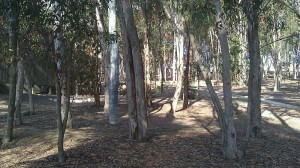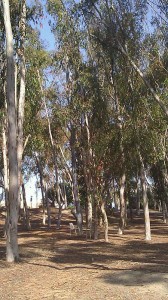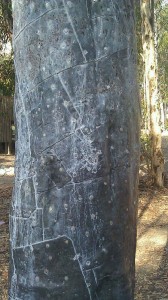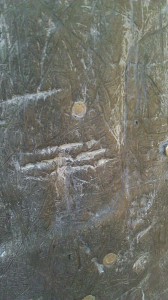There’s this dead tree outside my weekday office. A crew has been working on it for the last two weeks.
It’s one of three very dead trees that make up an 1986 installation by Terry Allen. Set in an area of the UCSD campus that’s seen many of the campus’ signature eucalyptus cut down to make way for buildings, they’re in part supposed to embody trees that were lost to the chainsaw of progress. The writeup at the Stuart Collection website has lots of things to say about the project, including: “Although they ostensibly represent displacement or loss, these trees offer a kind of compensation: one emits a series of recorded songs and the other a lively sequence of poems and stories created and arranged specifically for this project.”

Yes. Two of the artist’s trees make noise. Loud, annoying noise. So in effect this artists has taken a tree–something that to me represents the possibility of the quiet that you find in a grove–and replaces it with devices with speakers in them that pollute the thin grove with poetry and loud music. By banishing what’s left of the quiet it’s the aural equivalent of clearcutting what’s left of the trees. You call that compensation?
I do not love this work.

The trees in the project started out their lives in the adjacent groves but were removed. They were then dissembled and soaked in wood preservative. Once thoroughly embalmed, the trees were reassembled and sheets of lead nailed all over their outer surfaces. Over the course of 25 years the one mute tree–the one with the scissor lift next to it in the first phot above–developed the sort of white and yellow oxidation that lead can acquire over time. Oxidized lead makes up the artist’s pigment lead yellow, and sulfides of lead can turn the lead white.

I guess the natural processes went against the artist’s intentions of having a dark ghost of a tree the color of raw lead. The two workers have been pounding and cleaning and maybe even replacing some of the lead plating. The tree is starting to look really dead again.
My final thoughts? I don’t think this artist really gets nature. Natural processes are being denied. And now, you can’t hear the forest for the trees.



I haven’t visited the installation so I can’t comment on the quality of its sounds. I wonder if the maintenance on the lead surface is to keep its color and texture distinct from the living trees around it, in order to reinforce its difference from them?
I love your photo of the chair pulled up next to the sound tree. It connects the installation to its actual setting and the people who visit, and puts the sound tree on equal footing with all the other things around it.
I love your punchline. Perhaps someone could cut the power supply, accidentally?
James, I think, like you, I would find this art work irritating rather than evocative. In a world in which many people go around plugged into their mp3 players or on their cell phones most of the time, I think the appreciation of quiet or of nature’s real sounds are becoming rare.
Maggie, I’m maybe a little harsh in evaluating a work for failing to do something it didn’t intend to, particularly with the way the lead plating patinated. It’s only a small subset of art that aspires to rot or corrode into the earth, and this isn’t one of those works. I can see that battling natural forces could return the work to how it came from the workshop. The “compensation,” thing, though did get me going.
EE, I’ll have to work on that. It, and the cable attached to the source of the music is all underground.
Jean, very much agreed that quiet and natural sounds are getting rare. Destruction of the environment isn’t all visual. And even if the music were great to one person, isn’t it presumptuous that everyone else would think so? (I’d hate to subject too many people to my very particular musical tastes. I felt sorry for the neighbors this morning who got an earful of the new piano piece I’m working on…)
Ja,es, unless I’m reading this all wrong, isn’t there something really awful about killing a tree and then pretending it’s emitting music or poetry while it is encased in lead, when in reality, anyone with feeling might suggest, if the tree were able to emit a sound of its own, or if it were allowed to be heard, it would actually be lamenting its plight? Is this art at all, or just some terrible artiface? ( Forgive me anyone affected, if I’ve misunderstood this )
They make noises? Why? Besides, people walking by with their ipods won’t be able to hear it anyway. In the UNL campus, outside my office window, is a sculpture by Roxey Raine (for another week anyway–I was laid off from teaching). It’s a stainless steal dead tree. I kinda like it, but it doesn’t make noise. There’s always been controversy–is it art? Is it in the way? I find it moving in the winter more so than summer.
Man do I hate outdoor speakers of all kinds. They are an abomination, an offense against every birdsong and every whisper of wind through foliage.
Yes indeed, the artist does not “get nature”. Same with all the walkers in our beautiful neighboring coastal scrub sage park, who wear their headphones and miss a whole other aspect of the natural scene, the towhees rasping in the brush, and the mockingbird arias from above, even the crunch of gravel and leaves underfoot.
But a dead Euc gives me no end of satisfaction. “What a relief,” I think. “It’s dead and won’t shed no more.” I only wish it was the neighbor’s Eucs on my property line that were the dead ones.
I find dead trees beautiful in a sad sort of way (see snag in my Bend, OR post). Don’t you love the way ART gets people talking?
I think UCSD must have the worst art collection in the country. Terrible embarrassing stuff; people laugh when I describe the various pieces. Some of it was somewhat successful, though, as things to walk to and make fun of late at night after drinking in the dorms. That idea of embracing the suck, art so bad you start to celebrate it. I still can’t believe how bad that art collection is.
But I actually kind of liked the talking tree. I passed through that eucalyptus grove quite often and I liked how there was sometimes music coming from the tree and it would take a while to find which one. As an art piece I thought it was at about the level of a fifty dollar student project, but that’s a lot better than anything else in that collection.
I was there when they were installed and they were more isolated from the campus at that point. Stumbling across them while taking a short cut or hearing them late at night was always a mild pleasure – perhaps because they were so unexpected. The talking and singing trees didn’t do so all the time, so you might not know they were there if you were unobservant.
The campus has grown towards them since then, so perhaps losing their isolation has diminished their impact.
Faisal, you point out something very interesting. Who are these trees speaking for? You clearly feel they’re not speaking for themselves, and I’d add that we’ve put words in their mouths.
Benjamin, yikes, so sorry to hear about the teaching situation! What will this mean for your place in the Deep Middle? As far as the trees, your tree and the ones I showed seem to straddle the natural and cultural worlds, in part both, in part neither. Part art, part tree. That can raise all sorts of associations and expectations.
HB, that these are eucs are some consolation. In the end it’s a tiny notch out of the 200,000+ that were planted early in the last century. The campus is a quick walk from native torrey pine habitat, and I’d love to see the pines brought back as something other than isolated quotations placed around the campus. MUCH quieter than trees with speakers. The worst is the talking tree, when one of the poems has a shrieking background sound effect of a jet streaking overhead.
Ricki, covering a tree in lead sure gets you looking at it closer. The snag that you showed in your post, though, has lots of character of its own. Too bad people don’t pay them the kind of attention they should.
Ryan, although I’ve dished deep on this piece I think the campus has a couple stunning pieces in its outdoor zoo. My fav is probably the one that folks might make the most fun of, Robert Irwin’s delicate and sensitively place Running Violet V Forms. The piece is just purple fine-mesh chainlink raised up on stainless posts in the middle of the grove, but damn it’s the most wonderful thing to move around and watch the light change. It’s interesting how the collection takes to the outdoors works by artists who usually live indoors in galleries. Some works would be better houseplants and don’t hold up well to big outdoor space.
Brent, I pre-date the trees on campus and can appreciate how things have changed around them, changing how the work is perceived. Interacting with the work frequently over the years I’m starting to feel that how I see the work might be more like a museum guard’s take on a work they see all the time versus an infrequent visitor. Some pieces have grown richer over the years, this one didn’t get much beyond the surface.
I remember when you first posted about these trees. It’s a most interesting idea. Like you though I see no need for speakers in them. I find the discoloring of the lead most interesting. That lead surrounding the trees make the trees really different. Not a good kind of different as I’d hate to imagine a world full of trees encased in lead. Still, a neat sculpture.
I confess I rather like the texture on the dead trees from all that metal, and it somehow represents the way we keep destroying natural edifices to replace them with man-made edifices. But sound too?! Ghastly idea. I think you should get digging, the cable can’t be that deep…
Ha ha. Giant lead plated ipod tree, just what nature intended.